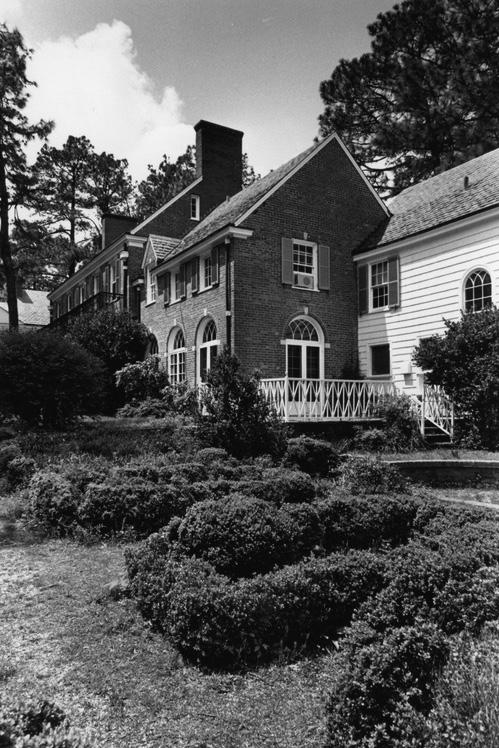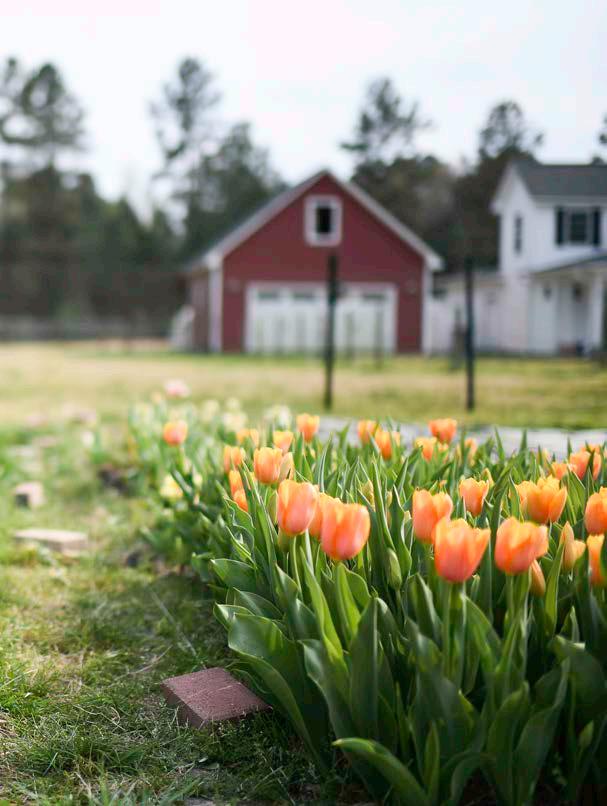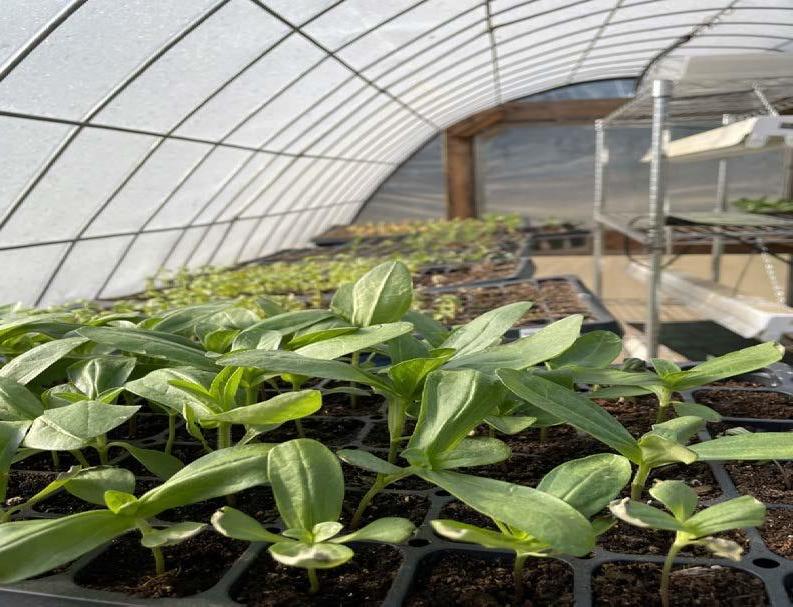
24 minute read
From the Editor
The Architecture

Advertisement

of Aymar Embury II

Story by Ray Owen Images courtesy of the Moore County Historical Association
In the first half of the 20th century, Aymar Embury II was responsible for designing the buildings in the Sandhills that provide the backdrop for daily life while setting us apart from any other place. These structures define our towns and are enduring expressions of the architect and the age in which he lived.
From 1912–1940, Embury was involved in more than 30 projects that were conceived as a cornerstone of civic development. His work represents a conscious effort at crafting a regional style, and his impact cannot be overestimated in the creation of our resort atmosphere.
With clarity of purpose he set about designing buildings worthy of a great society. Columned porticos, arching lattice-glazed windows and thoughtful details characterize his work. The public face he created was deemed essential in light of what good architecture would build for us.
As a trend-setting New York architect, he was responsible for numerous public buildings, swimming pools and playgrounds, and hundreds of estates outside the city. Noteworthy examples of his work are the Central Park Zoo and the Triborough, Henry Hudson and BronxWhitestone bridges.
His arrival in the Sandhills was prompted by a series of catastrophic fires, the first being in 1910 when the Piney Woods Inn—the grand hotel of Southern Pines—burned to the ground in less than an hour. Another fire swept through downtown in 1921, destroying nearly the entire commercial district.
With so much hanging in the balance, Embury had an opportunity to establish a new building heritage. The community’s native style was that of a rural forest society, and he looked beyond this for more suitable precedents to facilitate the growth of our budding resorts.
He brought to the task an understanding of historic architecture from years of study in early Carolina towns. Informed at least in part by buildings in New Bern, Embury reached into the past to launch a consolidated reinvention, picking from history the parts that fit best.
Rather than replicate existing structures, he felt it important to use past examples as points of departure, adapted to modern needs. His buildings represent a series of compromises between practical considerations and harmonic layout.
Embury saw himself as crafting the stage on which people lived, essentially art you could walk through. Upon entering his rooms, you see him clearly aiming for the light, ever mindful of the play between shadow and illumination.
Nowhere is his skill more apparent than at Weymouth, the estate of writer James Boyd and the largest of his residential projects in Southern Pines. The design centers around a great room, the focal point being a mantel salvaged from a local antebellum home, complemented by paneled walls, fine moldings and doorways with fluted pilasters on either side.
In 1911, the Boyd family commissioned Embury to design the Highland Pines Inn, once situated on Massachusetts Avenue in Southern Pines. The inn featured three main entrances with tall columned porches and contained 100 bedrooms and an array of public rooms, with amenities such as world-class golf, horseback riding, fox hunting and tennis.
It is hard to imagine that the social hub of Southern Pines was once located in what is now a quiet residential neighborhood. The guest book read like the society pages of The New York Times, including literary giants such as F. Scott Fitzgerald and Thomas Wolfe.
Embury was a pleasant man, aristocratic with a commanding presence. Always in a tailored suit, smoking a cigarette, he was forever looking like the guy in charge. With a twinkle in his eyes, he was quick with a joke and good at making others laugh. He particularly enjoyed the married state and made the trip down the aisle four times.
Born in New York in 1880, he was no stranger to wealth and privilege. Educated in Germany, he developed an interest in architecture during European tours, entered Princeton University at age 15 and received his master’s degree before age 21.
Following graduate studies, he taught at Princeton while working for various New York firms. Nearly starving as an apprentice, he was fired from his first job after asking for a raise. Fashionably thin, he had enough clothes left over from better days to look well dressed on his ascent up the corporate ladder.
At the time, firms operated on a studio system that was highly competitive and based on scholarly study. Classical designs were analyzed first, followed by an exploration of all styles. The atmosphere was tempered by a need to succeed financially. Embury flourished in this environment, developing the discipline that would mark his success.


Opening spread, clockwise, from top left: Loblolly home, Southern Pines; Mid Pines Golf Club, Southern Pines; Southern Pines streetscape; and the Theater Building, Pinehurst Opposite page: Aymar Embury II / Above: Southern Pines School / Below: Highland Pines Inn, Southern Pines

For 12 years after college, Embury never took a single day off, including weekends. He began drawing plans of small houses that proved popular. His homes increased in size and importance, earning him a reputation as a society architect for the wealthy.
He ultimately published several books on architecture and his designs were reproduced nationwide. His study of New Bern from the White Pine Series of Architectural Monographs was an important work that informed projects in the Sandhills.
In Southern Pines, the Highland Pines Inn served as the springboard for his career. The Boyd family subdivided 500 acres east and south of the inn, forming Weymouth Heights. Embury began designing residences in the subdivision for those who wanted to use the resort facilities but have a private home.
Before his arrival, most local carpenters had never seen a blueprint. They were keen to learn and Embury taught them skills to carry out his designs. He also imported contractors for the more exacting commissions. Some of the contractors stayed on, contributing to a building renaissance.
Loblolly was a pivotal Embury design in Weymouth Heights that had a profound effect on regional taste. Built in 1918 for Mrs. A.P.L. Dull, the structure features an irregular profile with a combination of loosely connected rooms oriented horizontally, accentuated by multi-pane casement windows and adorned with brick checkerboard patterns.
At Loblolly, Embury varied surfaces to capture the appearance of a place that had evolved over time. He was most concerned with the building’s outlines and shadows, and used exterior treatments that emphasized lines of tension, almost suggesting bones under skin.
In 1925, Embury created an “ideal house” in Pinehurst, built to serve as a prototype for residential design and showcase the quality of local craftsmanship. Trade vendors constructed the house as a cooperative venture and the model remained open throughout the 1925–1926 season.
His work was appreciated for its beauty and usefulness in increasing property values. The Southern Pines mayor suggested, not completely in jest, that the town allow no buildings except those designed or approved by the architect.
It is impossible to know what the Sandhills would have been were it not for Embury. He left an enduring mark, creating buildings that shaped us as a people. By the time of his death in 1966, he was considered one of the foremost architects in the country. Inscribed on his gravestone are the words “After me cometh a Builder. Tell him, I too have known!”PL

Above: Embury on the links / Below: Weymouth

In Bloom
Story by Greg Girard Photos courtesy of Marissa Podszus, Kate & Gray Photography
In the perfect symbiotic relationship between art and nature, impressionist Claude Monet’s passion for flowers was mirrored to perfection in his works. His life was a measured balance between his painting and his flowers. “I must have flowers, always, and always,” he said. His gardens at his home in Giverny, France, inspired many of his works and he once commented, “My garden is my most beautiful masterpiece.”
There is, as Monet insightfully points out, something about flowers. It would take a hard heart not to stand in awe at the tulip farms of the Netherlands, the poppy fields of Belgium or the spring explosion of azaleas in the Sandhills. Flowers inspire emotion, and it’s one of the reasons Sarah Mergen established the Little Way Flower Farm in Aberdeen.


“I grew up in my mom’s flower gardens,” says Sarah. “I’m from a really small town in Wyoming—13 kids in my graduating class—so everybody in town would walk by our house to look at Mom’s flowers. I just always have had flowers in my life. When we moved to the Sandhills, I grew flowers in our backyard in Pinehurst. I was giving them away and I was quickly running out of room. So I started to think, maybe I should try this on a larger scale.”
Friends with acreage in West End offered some of their land for Sarah to experiment on and the rest, she says, was history. Last year Sarah, her husband, Ryan, recently retired from the military, and their three boys moved onto five acres in Aberdeen and Little Way Flower Farm was born.
The farm, at the moment, is not very large but certainly at a size that would have outgrown any backyard project. It’s early spring, so Sarah points out rows of tulips, daffodils, ranunculus and anemone that have bloomed or are on the cusp. Other rows lay dormant, ready for different seasons: zinnias, sunflowers, snapdragons, dahlias and more. There’s plenty of space to expand and Sarah shares they have a realistic, and patient, plan for the business to grow. For now, it’s about understanding the land and how the different flower varieties will respond to the climate and soil. As noted on the farm’s website, “Our emphasis on regenerative and sustainable farming practices is reflected in everything we do.”
She says: “No surprise, it’s a bit sandy here but, honestly, I would rather work with sandy soil than compacted clay. With the sandy soil, we add organic material to give it a little bit of girth so the water’s not just draining away. We grow without any chemical interference. We don't fertilize with chemicals. We have a huge pile of compost, organic eggshells and other organic material. And so we broad fork that in with some leaf mulch. And then to fertilize, we spray our plants with a fish emulsion, which is exactly what it sounds like. It smells disgusting but it’s great for the flowers—everybody on the farm hates fish emulsion day. We also use a little bit of bone meal. All organic.”
At this point in the farm’s genesis, it’s still a healthy dose of trial and error, especially on land she hasn’t had much experience working. “There are a lot of things that probably won’t work out and we just plan for that,” she

Photo by Jennifer B. Photography




says. “Twenty-five percent of what we try to do is probably not going to take and I just keep notes so that when I feel like I want to grow that same flower next year and I’m trying to convince myself to do it, I can check my notes that said, ‘Don’t do that! It didn’t work.’
“Every day, I’m learning more and more. There are lots of life lessons in the garden. So it's been good for us and something to do as a family, too. We wanted something that we could call ours, that the kids could grow up doing. Literally and figuratively grow something together. And truly, I think we’ll do this forever no matter if we continue at a large scale or just for ourselves.”
Last year wasn’t the most ideal time to start a flower farm business. The flower industry was particularly impacted by the pandemic as shutdowns in the northern hemisphere occurred during wedding, event and hospitality season. Globally, the cut flower industry is an $18 billion juggernaut and Europe alone saw the market lose $1 billion during the first six weeks of the 2020 shutdown. U.S. cut flowers sales fell dramatically as well.
Sarah’s not fazed, though, and she points to the power of the local community. “Flowers are a part of our life,” she says. “Ultimately, we want to bring locally grown flowers to Moore County because the people who live here love and support local businesses. When people in Moore County want flowers, I want them to say, ‘Let’s go to Little Way Flower Farm.’ This community is incredible and it’s just–—the possibilities are really endless.”
Little Way Flower Farm sells flowers to local florists, through subscription boxes via their website (littlewayfarms. com) and you’ll often see her bouquets for sale at Against the Grain in Southern Pines.
Monet found solace and inspiration in the colors and bouquets of his flowers; the Mergen family is finding the same at Little Way Flower Farm. PL
HOME is not safe for everyone.
Friend to Friend is Here to Help.
24 Hour Crisis Line 910-947-3333
Domestic violence, sexual assault, or human trafficking emergency shelter, support, information, and referrals Emergency Shelter

A safe residence where our guests are given the opportunity and support to begin healing physically, emotionally, and mentally Court Advocacy 910-947-1703
Protective order assistance, court related questions, court accompaniment, and counseling services
Community Outreach
Provide information and education to the community about domestic violence, sexual assault, and human trafficking
Hospital Accompaniment
A trained advocate to provide immediate, inperson support to adult survivors of sexual assault available 24/7 Support Groups
Facilitated virtual support groups for survivors of domestic violence, sexual assault, and human trafficking.
For more information visit www.friendtofriend.me

The Sandhills’ premier boutique for children’s and women’s needs with a
elegance.
Nursing and maternity fashion up to age 8 Sustainable toys
Bump & Baby | 3 Market Square | Pinehurst 910.420.8655|thebumpandbaby.com Find us on Facebook! Find us on Instagram!
GET COMFORTABLE WITH US!

4 Seasons Heating & Air
132 Westgate Drive, West End, NC 27376 Phone: (910) 235-0606 Fax: (910) 215-9653
www.4SeasonsHeatnAir.com Call today to learn more about our Maintenance Contract - providing homeowners peace of mind, preferred pricing on service work, and a performance guarantee.
Americans have been experiencing some form of Mexican food for centuries, well before most of the Southwest was divided into states. In the early 20th century, the Mexican Revolution caused a wave of refugees to venture north, introducing a plethora of dishes from Mexico, particularly from southern Mexico, like the taco.
Tex-Mex, which introduced our palates to popular plates like burritos, fajitas, chimichangas and nachos, originated in the U.S. around the 1940s. Relying more on spices like cumin, heavier cheeses and meats, Tex-Mex is now often considered part of the Mexican restaurant experience.
Today, Mexican restaurants are as ubiquitous to our ethnic dining experience as Italian or Chinese, but the debate that often arises is what constitutes authentic Mexican cuisine. Can the food offered at more than 6,000 Taco Bell restaurants be considered “Mexican”? What about your local Mexican restaurant? How traditional is their menu?
Purists note: To experience truly authentic Mexican, one should find dishes that include spices like coriander and epazote, maize and wheat soft tortillas, white cheeses, and fresher, healthier ingredients. One expert on the evolution of Mexican cuisine in the U.S. suggests looking on a menu for a dish that’s only in Spanish. He says odds are it will be a more authentic Mexican dish and will be worth a try. To follow are a few authentic recipes to try at home.

Mexican Cuisine
Fresh Salsa

mexicoinmykitchen.com / Yields 3 cups
Ingredients
1¼ pounds ripe tomatoes, about 3 large tomatoes or 5 Roma tomatoes ¼ cup chopped onion, about ¼ of a medium onion 2 jalapeño peppers chopped 1 garlic clove small 1/3 cup cilantro finely chopped 2 tablespoons onion finely chopped (for garnishing) Salt to taste
Directions
Roughly chop the tomatoes, onion and peppers to get them ready for the blender.
Place the garlic, chopped tomatoes, onion and peppers into the blender. Process for about 1 minute or less until you have a salsa that still has some texture to it.
Place the salsa in a large bowl, season with salt and stir well. Garnish with the chopped cilantro and onion. You will never buy store-bought salsa again!

Churros
thebossykitchen.com / Serves 4–6

Ingredients
½ cup water ½ cup milk 1 tablespoon neutral oil like canola ¼ teaspoon salt 1 cup all-purpose flour 1 large egg, room temperature ¼ teaspoon grated lemon zest Additional oil for frying ½ cup sugar ¼ teaspoon ground cinnamon
Directions
In a large saucepan, bring the water, milk, oil and salt to a boil. Add flour all at once and stir until a smooth ball forms. Transfer to a large bowl; let stand for 5 minutes. Beat on medium-high speed for 1 minute or until the dough softens. Add egg and lemon zest; beat for 1–2 minutes. Set aside to cool.
In a deep cast-iron or heavy skillet, heat 1 inch of oil to 375 F. Insert a large star tip to a pastry bag; fill with dough. On a baking sheet, pipe dough into 4-inch strips.
Transfer strips to skillet and fry until golden brown on both sides. Drain on paper towels. Combine the sugar and cinnamon; sprinkle over churros. Serve warm.
Oxtail Beef Stew with Poblano Peppers
mexicoinmykitchen.com / Serves 6
Ingredients
TO COOK THE OXTAIL 2½ to 3 pounds beef oxtail Salt and pepper to season the meat ¼ medium-size white onion 1 bay leaf 2 garlic cloves 4 cups of water
FOR THE SAUCE 2 poblano peppers 4 large plum tomatoes, about 1 pound 2 garlic cloves peeled and chopped 2 tablespoons of olive oil ½ medium-size white onion, julienned 2 serrano peppers, cut into strips. 4 tablespoons tomato paste or ½ cup tomato puree Salt and pepper, to taste ¼ cup chopped cilantro, to garnish
Directions
Season the oxtail meat with salt and pepper. Place meat, onion, garlic and bay leaf in a stockpot along with the 4 cups of water. Cook the meat for 40 minutes or until tender and can be easily separated from the bone. Remove the meat from the bones.
While meat is cooking, roast the Poblano peppers by placing them directly over a medium flame. Turn them to have an even roasting, making sure you don’t burn the peppers. Remove them promptly, and place inside a plastic bag for 5 minutes. Meanwhile, roast the tomatoes.
Place the tomatoes on a hot griddle to roast, turning once on every side until it has roasted; you will know it is ready by the formation of a large brown spot. After they are roasted, remove from griddle.
Remove the charred skins from the poblano peppers by rubbing your finger against their skin (if you can’t remove all the skin, that is ok; the roasted skin adds more flavor to the dish). After discarding the seeds and removing the veins, cut the peppers into strips and set aside.
Chop up the roasted tomatoes and place them in a blender along with the garlic cloves and 1 cup of water. Process until you have a chunky sauce.
Heat the oil in a large skillet over a medium-high heat. Stir in the onion, sauté for one minute, and then add the serrano pepper strips. Keep cooking for one more minute. At this time, pour in the blended sauce, 1 cup of the oxtail broth and the tomato paste. Stir well and cook for 5 more minutes.
Finally, add the meat and poblano peppers, season the sauce with salt and pepper. Keep cooking for 8 more minutes in a gentle simmer. If the sauce needs more liquid, add more of the oxtail broth. To serve, garnish with the chopped cilantro.
Notes: If you don’t find serrano peppers, use 1 jalapeño pepper.

Tinga de Pollo
thebossykitchen.com / Serves 4–6
Ingredients
3–4 medium size chicken breasts 4–5 tablespoons of oil 1–2 large onions, sliced 4–5 medium Roma (plum) tomatoes 1 can of Chipotle chiles in Adobo 2–3 garlic cloves 1 ½ teaspoon salt, or to taste ¼ teaspoon Mexican oregano ¼ teaspoon dried thyme ¼ teaspoon dried marjoram ¼ teaspoon black pepper
Directions
Bring a pot of salted water to a boil and add the chicken breasts to cook. Let the chicken simmer until cooked through. Make sure you skim the foam that forms on top of the water as it starts bubbling.
While the chicken is cooking, place the tomatoes in a medium saucepan, cover with water, bring to a simmer over medium-high heat and cook for 8 to 10 minutes, or until the tomatoes are soft and mushy but not falling apart.
Slice the onions thinly. Heat the oil in a large pan(skillet) and add the onion. Cook the onion until soft and translucent for about 5–6 minutes.
In a blender, throw the tomatoes, garlic, salt, pepper and 2–3 chipotle chiles from the can. Be careful with the chiles, as they can be very spicy. Note that the original Mexican recipe calls for the entire can of Chipotle.
After blending the ingredients, taste the salsa for salt and pepper, and adjust if needed.
Pour the salsa over onions. Add oregano, marjoram, thyme and pepper. (Be careful: The sauce will steam and bubble.) Simmer the sauce, stirring occasionally, until the sauce deepens in color, becomes darker and less soupy, about 7–8 minutes.
Take the chicken out of the broth and with two forks, shred the meat. Add it to the sauce and mix well to incorporate the chicken. Let it simmer for only a minute and serve over rice or on warm tortillas.
LP
Wine Haven
By Sassy Pellizzari
Do you dream about a building a fabulous wine cellar in your house? Maybe you have a coffee table book that you ogle at … Living With Wine or The Most Beautiful Wine Cellars in the World. Maybe you envision it as a tranquil, crypt-like sanctuary, where you can go to find peace and study your wines on your palate. Or maybe you dream of it more as a party space meets tasting room, a place to host guests with not only great wine, but a fun area with fabulous lighting; surround-sound music; a long, elegant table and prosciutto hanging from the ceiling. Or perhaps you already have your dream cellar. Or you prefer your wine in your kitchen, easier to grab when you’re cooking or your kids are fighting.
There is an aura so artistic and luxurious about a wine cellar, it is hard not to be enthralled by them. Some of my most memorable travel memories were visiting wine cellars around the world, and this was even before I cared about wine.
The infamous Antinori family created a magnificent, modern wine cellar literally carved into the side of a hill in San Casciano, Tuscany. Designed by a premier Florentine architectural firm, dreams became reality as huge terracotta wine vaults are concealed beneath a vineyard, which flourishes literally on top of the winery. Despite years of problems during construction, from landslides to bureaucracy, it is now open for tours and dining, when at the restaurant. (Note: Add this to your bucket list.)
Then, there was the private home that I visited in Lebanon, with the wine cellar built into the hill of AlAshrafiyyah (East Beirut). You could see the sparkle of the Mediterranean Sea’s turquoise water as you slowly descended the circular iron steps into the ancient limestone walled vault. Since the ambiance and the experience was so incredible, I can’t even recall what wines were stored there.
Right here in Pinehurst, we have friends with a stunning cellar where we have made many great memories together. Valuable bottles line the walls, encased in glass for optimal temperature control. A long and welcoming tasting table is surrounded by the columns and rows of bottles. The design creates an elegant yet casual and





friendly feeling, which sets the stage for a delightful evening.
Wine cellars can really be anything your imagination, contractor and budget can realize. There are a few must-haves for storing wine, however, if you do intend to actually drink it and not just enjoy the space.
The first is lighting. Wine, like the stars in the sky, needs darkness to shine. Light can ruin not only the color of wine, but also the aromas. This is why wine cellars are, well, cellars: a room built in the ground where sunlight cannot reach.
Another important factor for storing wine is the position of the bottle. If you intend to wait a year or even a few months to drink the wine, you should not leave it in the vertical position. The perfect position is horizontal, especially if it has a pure cork tap. The liquid should stay in contact with the cork, which avoids excessive oxygenation that damages wine.
Humidity is not a bad thing, but too much humidity is. It is fundamental to find an optimal balance of humidity for conserving wine. If the air is too dry, you risk that the cork dries out, which allows oxygen to pass through to the wine. On the other hand, if the humidity is too high, you could create mold, which is what gives corks that “tapped” smell. Experts say that the perfect humidity for storing wines is between 75 and 90 percent.
Have you noticed how, when descending into a cellar, you feel slight chill and suddenly need a light sweater? The best conservation temperature for wine is actually between 52 and 59 degrees, give or take a few degrees. It also depends on the wine: some whites prefer to stay under 52, while other reds age better slightly above 60 degrees. It is fundamental to keep the temperature consistent. If it is too cold, the natural aging of the wine may be obstructed, while if it is too hot, the heat will accelerate the aging process of the wine, risking to ruin it.
Finally, wine needs a calm environment with no distractions. This means no strong odors, no vibrations such as from the street or appliances, and good air circulation.
Just like us, in order to age gracefully, wine needs the perfect conditions. Adding all the bells and whistles makes aging gracefully more enjoyable along the way. PL




Sassy Pellizzari lived in Italy for more than 13 years, where she developed a passion and knowledge of Italian wines. She and her husband, Paolo, are the owners of Bacco Selections, a Pinehurst-based company specializing in fine wine importing and distributing.

The Village Chapel
The Village Chapel is an interdenominational church welcoming and embracing all Christians.
Sunday Worship Services
8:15 am - Communion Service 9:30 am - Family Service 11:00 am - Traditional Service
Sunday Radio Broadcasts
WIOZ 550 AM - 8:00am WLHC 103.1 FM - 8:30 am
You’re Welcome Here!
10 Azalea Road • Pinehurst, NC
tvcpinehurst.com • 910.295.6003 info@tvcpinehurst.com
FUN WITH FUN WITH Flats Flats
SHOP NOW
online & in store
135 Beverly Lane
(next to Fresh Market) 910.684.8546
Monday - Friday 11 - 5 Saturday 11 - 4







